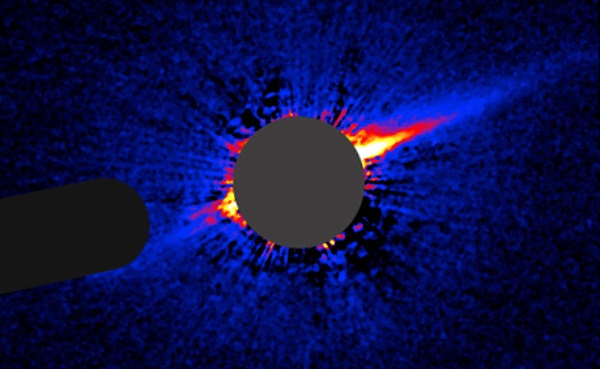A stronomers using the Hubble Space Telescope (HST) and W.M. Keck Observatory have found a lopsided debris disk around young star HD 15115. As seen from Earth, the edge-on disk resembles a needle sticking out from the star.
Astronomers think the disk’s odd, imbalanced look is caused by dust following a highly elliptical orbit about the star. The lopsided disk may have been caused by the gravity of planets sweeping up debris in the disk, or by the gravity of a nearby star.
The observations were made by Paul Kalas, James Graham, and Michael P. Fitzgerald, all from the University of California at Berkeley.
“The lopsided disk presents a host of new challenges for theorists,” said Kalas.
Debris disks are produced by dust from collisions among protoplanetary bodies, building blocks of planets. These dusty disks can be affected by planets near the star, much as Jupiter’s gravity affects asteroids in the asteroid belt.
This discovery is consistent with models for planetary upheavals in our own solar system, where Neptune may have originally formed between Saturn and Uranus. Neptune was eventually kicked out to its present location by a gravitational dance between Saturn and Jupiter before their orbits stabilized. “Therefore, we speculate that if such a planetary upheaval were occurring around HD 15115 at the present time, it could explain the highly asymmetric disk,” Kalas said.
This might happen through a powerful gravitational interaction between planets that kicks one or more planets into highly elliptical orbits, or even ejects them into interstellar space. When the planet’s orbit becomes elliptical through a violent upheaval, the rest of the disk can be disturbed into an elliptical shape, according to Kalas.
Kalas also is studying whether the gravity of a star known as HIP 12545, located about 10 light-years from HD 15115, may have created the disk’s lopsided shape due to a close encounter in the past.
Dusty disks are known to exist around at least 100 stars, but because of the difficulty in observing material within the glare of a star, less than a dozen have been studied closely.
HD 15115 and HIP 12545 are among nearly 30 stars that belong to the Beta Pictoris moving group. Moving groups are expanded clusters of stars believed to have a common birthplace and age that travel loosely together through space.
The dusty disk around HD 15115 was first inferred by observations at infrared wavelengths in 2000 — its existence was confirmed in 2006 when HST resolved the disk in reflected light for the first time. The disk was investigated further using Keck adaptive optics in 2006 and 2007.
“The disk was seen in the HST data, but its appearance was so extraordinary we could not be certain that it was real. It took follow-up observations at Keck to confirm that it was a real disk,” Kalas said.










